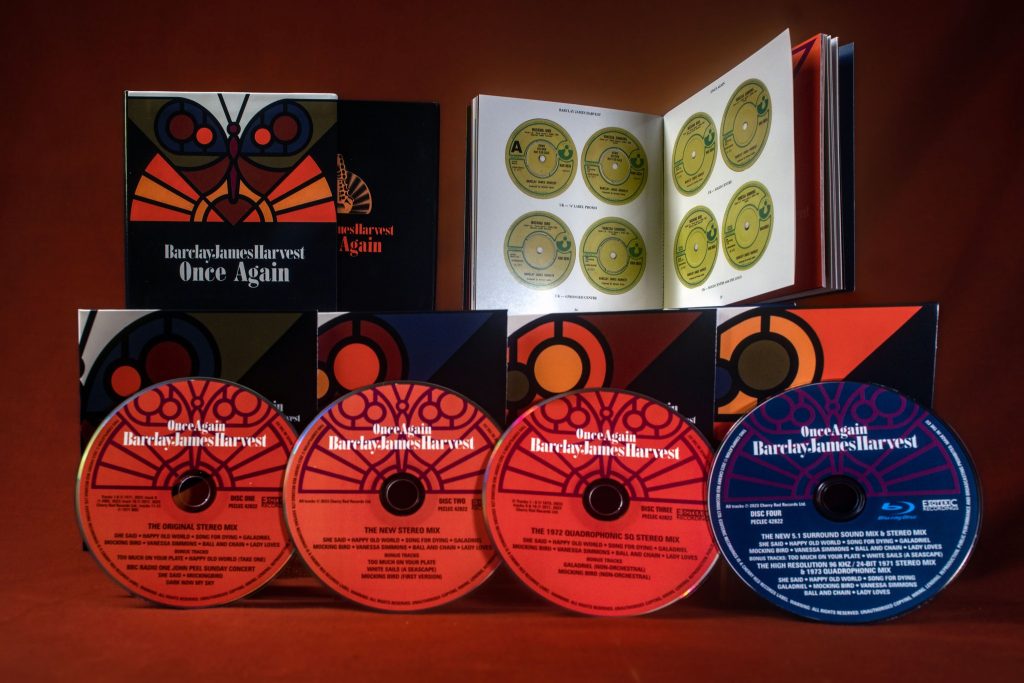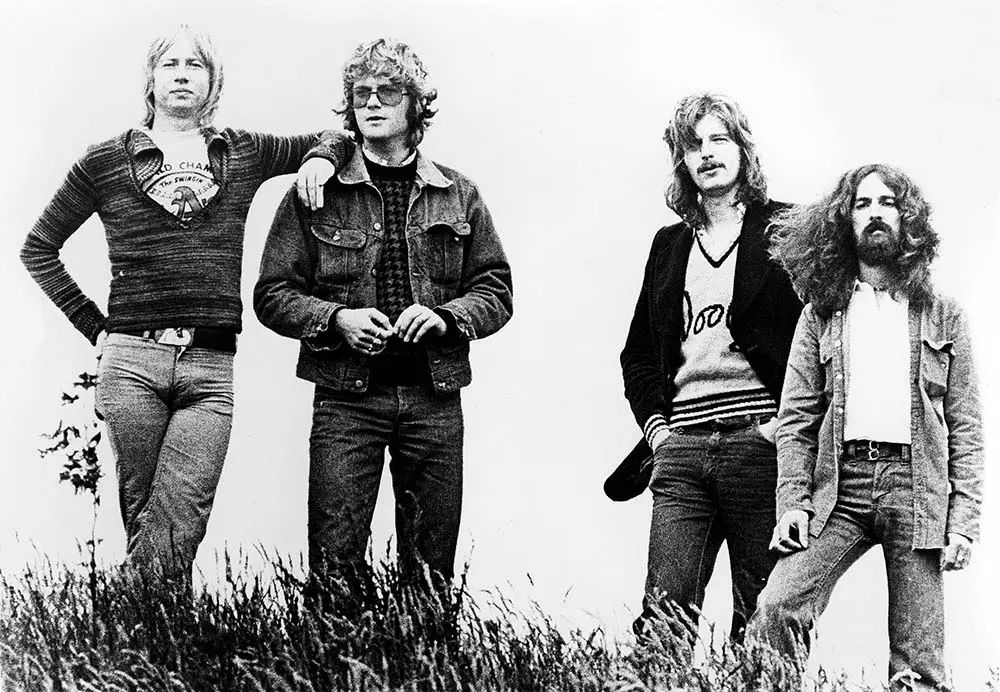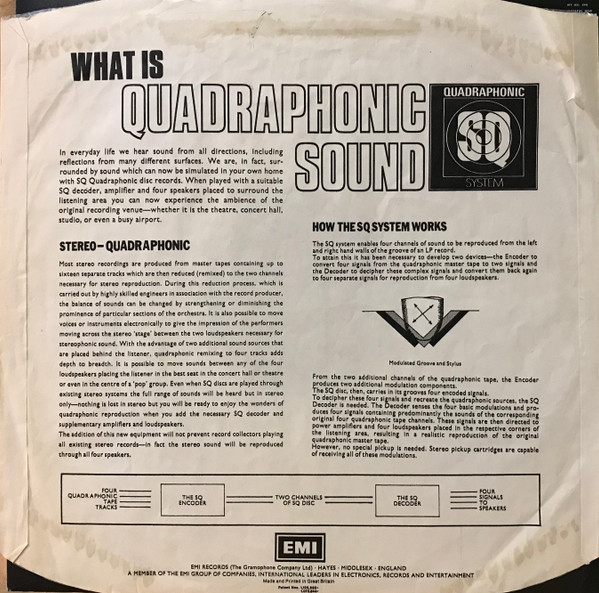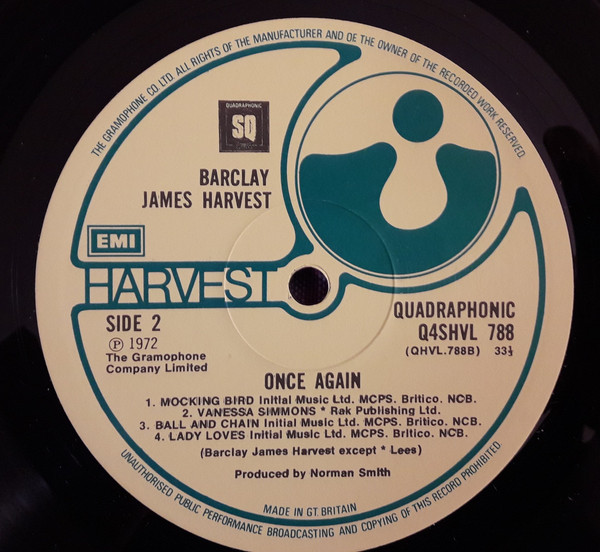Barclay James Harvest are yet another British progressive rock act who’ve caught my attention by having much of their back catalog remixed in 5.1 surround sound. An extensive series of reissues from the Cherry Red/Esoteric label began in 2016 with the Everyone Is Everybody Else (1974) and Gone To Earth (1977) CD/DVD editions, and has since covered a vast portion of the band’s discography including 1976’s Octoberon, 1971’s Barclay James Harvest and Other Short Stories, 1978’s XII, and the 1970 debut album.
Though the last several albums were mixed in stereo & 5.1 surround from the original multitrack tapes by Ben Wiseman & Esoteric label head Mark Powell, remixing duties for Once Again (1971) instead fell to Stephen W Tayler. Tayler has been involved in a number of well-received reissues from the Esoteric label including the Be-Bop Deluxe and Van Der Graaf Generator deluxe editions.
This Blu-Ray disc includes a whopping five(!) unique mixes: the original 1971 stereo mix (remastered by Ben Wiseman), the 1972 quadraphonic mix (in both SQ matrix encoded stereo & discrete form), and finally Tayler’s new stereo & 5.1 mixes. If you’re someone who enjoys comparing and contrasting various different iterations of the same material, this disc is a real feast for the ears.

The 1971 stereo mix definitely shows its age, especially with regards to the hard-panning. The drum kit in the opening track “She Said” is pushed way off into the right channel, with overdubbed snare rolls panning across the stereo field from right-to-left (the quadraphonic version carries this over by having said drum rolls spin all the way around the room!). Unsurprisingly, Stephen W Tayler’s new stereo mix opts for a more balanced presentation by centering the drums & bass. The 5.1 mix expands things out a bit further by relocating those snare rolls and the cavernous plate reverb to the rear channels.
Moving into “Happy Old World,” the tape hiss that permeates the intro section has been noticeably toned down in the new mixes. Drums are again centered, with the organ on the left and piano on the right. I would’ve liked to hear the group backing vocals during the chorus spread out into the rear speakers on the 5.1 version, but perhaps all the singers were captured together using a single microphone?
“Galadriel” is another highlight of the 5.1 mix, with the orchestration emanating almost entirely from the back speakers. In addition to the more-modern planning scheme, the new mixes seem to add a bit more ‘punch’ in the rhythm section (just listen to the drums throughout “Ball & Chain”) and push the lead vocal a bit further forward in the picture.
The 5.1 surround mix isn’t terribly adventurous to my ears, but it does effectively ‘deepen’ the soundstage by placing a lot of the reverberation and delays in the rear speakers (in addition to some unique elements like guitar, keys, and backing vocals). Lead vocals are spread across all three of the front channels, rather than residing solely in the center speaker.

Once Again is unique in that it’s the only album in the band’s discography to receive a quadraphonic mix. During the early ‘70s, EMI commissioned four-channel remixes of several notable albums in their catalog – including Pink Floyd’s Dark Side Of The Moon and Atom Heart Mother – and released them in specialized LP & 8-track tape formats only in the European market. The quadraphonic version of Once Again was released nearly two years after its stereo counterpart and only on LP, with no 8-track counterpart.
EMI’s quadraphonic LP’s used the CBS “SQ” matrix encoding process, meaning that one would need to purchase an external decoding device to extract the rear channels upon playback. Unfortunately this extraction process – which used phase shifting circuitry to recover the rear channel information – was imperfect, causing the front and rear channels to blend together and create an incoherent soundfield. The quad 8-track tapes had perfect front-to-rear channel separation, but suffered from all the maladies of that format (poor high-frequency response, imperfect speed, etc).


Having been mixed to take full advantage of the SQ matrix process, the quadraphonic mix comes off as a bit extreme by modern standards – especially during the first track, where the lead vocal is completely isolated in the right rear speaker – but it does effectively open up the album by separating out the organ and guitar parts to the back channels. Plus, the extreme panning is also faithful to the original stereo mix.
I’d characterize the new 5.1 mix as a gentle expansion of the stereo field, while the quadraphonic version sounds like you’re sitting in the studio with the band as they’re recording the album. Both perspectives are interesting and I’m glad to have them together on the same disc.
Immersive music fans may recall that the discrete quadraphonic mix was first reissued in 2011, as part of the 40th anniversary CD/DVD edition of Once Again. I was pleasantly surprised to discover that the quad presentation on this new Blu-Ray is not only different, but a clear improvement over the 2011 DTS-encoded DVD. The removal of the unnecessary derived center channel (which appears to be nothing more than a mono summation of the front channels) is a positive, but it also seems to exhibit more dynamic range and thus less harshness at higher volume.

For those old-school fans that continue to maintain vintage quadraphonic decoding equipment, the inclusion of the SQ-encoded stereo mix on the Blu-Ray disc is a fun bonus. Interestingly enough, this is not the first time it's been reissued in a digital format: it appeared first on the 1998 Brimstone CD reissue and then again in the 2011 CD/DVD set. There are also some reports that the HDTracks high-resolution digital download of Once Again is sourced from the SQ-encoded master.
Though this set is a great value and I wouldn’t hesitate to recommend it to any immersive music enthusiast, I was kind of disappointed to find the new mixes in stereo & 5.1 a bit bright-sounding in comparison to the old stereo & quad versions. Said brightness isn’t as bothersome to me as on the recent Al Stewart Year Of The Cat and Time Passages 5.1 remixes (also issued through the Esoteric label), but some of the busier passages with crashing cymbals get to be a bit fatiguing at higher volume.

